|
|
 |
 |
 |
 |
 |
 |
 |
 |
 |
DinoBirds - The Feathered Dinosaurs of China |
 |
 |
 |
 |
| |
The FirstScience.com
Six Atom Rating System |
|
| 1 Atom
= Miss |
3 Atoms
= OK |
5 Atoms
= Very Good |
| 2 Atoms
= Poor |
4 Atoms
= Good |
6 Atoms
= Outstanding |
| Exhibition
Review: |
DinoBirds - The Feathered
Dinosaurs of China |
| Worth Visiting Rating: |
 (Outstanding)
(Outstanding) |
| Presentation, Layout
and Explanations: |
 (Just Ok)
(Just Ok) |
| Venue:
|
The Natural History
Museum, London – 020 7942 5000 |
| Nearest
Tube: |
South Kensington |
| Dates:
|
18th July
2002 to 5th May 2003 |
| Cost:
|
£3.50 adults,
£2 concessions free to under 5s and
members. (See
www.nhm.ac.uk/dinobirds for details)
Entry to the Museum’s Main Galleries is Free |
Reviewed By Stuart Brown
DinoBirds
is the new exhibition at The Natural History Museum that aims to
pull together all the different pieces of a jigsaw puzzle that points
to how modern birds are linked to dinosaurs in evolutionary terms.
This has been achieved through a unique
collaboration between China and Britain that sees the two most startling
fossil discoveries that support this thesis brought together in
the same room for the first time.
The story really starts with the discovery
in 1861 of a fossil in a limestone quarry in Bavaria, Germany. It
was found by a quarryman, who recognising it to be valuable, exchanged
it with an amateur collector, Dr Karl Haberlein in settlement for
a medical bill. It was named Archaeopteryx (meaning ‘ancient
wing’), and announced to the world as a major find. In 1862
fate smiled on The Natural History Museum, as Haberlein, hoping
to raise a dowry for his daughter, approached the British Museum
offering to sell his entire fossil collection, which included the
Archaeopteryx, for £750 (equivalent to £34,522 in 2002
prices). Amazingly, the museums trustees were reluctant to do the
deal, but Richard Owen, the Superintendent of the Natural History
Department was sufficiently tenacious, and after six months a payment
deal spaced over two years was done.
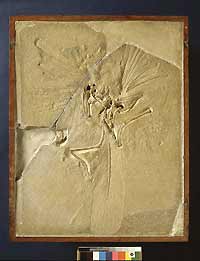
(C) The Natural History Museum
Archaeopteryx
|
Ironically, the Archaeopteryx is now
considered probably the Natural History Museum’s most treasured
specimen, and in scientific terms priceless. This in fact is the
first time since 1988 that the original specimen has been on display
at all. An exact mould was taken of it, and it is generally that
that goes on display. So this is a great opportunity to take a look
at the real thing at close quarters. It is very fragile, and so
unlikely to be allowed to travel if the exhibition does visit other
cities.
To understand why this specimen is
so important it is necessary to consider it’s ramifications.
Here is a fossil specimen that seems to be of a bird, and yet it
has claws, a bony tail and other features that would place it more
as a dinosaur. It is these seeming anomalies that mark the find
out as a unique evolutionary snapshot, rather then just a rare fossil.
The first person to recognise this properly was Thomas Huxley, who
argued that the find was not just an ‘ancient, long-tailed
bird’ as Owen thought, but rather proof that birds and dinosaurs
were linked, showing the first signs of evolutionary change that
would mark the beginning of a 140 year search to solve the mystery
of how birds are related to meat eating dinosaurs.
This exhibition has been made possible by the unique finds in the
Liaoning region of Northeast China. Only the Archaeopteryx is in
fact owned by the Natural History Museum; the rest of the finds
are on loan from China, which allowed them to come to the UK for
conservation at the Paleontology Conservation Unit (PCU) at the
Natural History Museum, which is recognised as the world leader
in the field. Thus allowing the full story of the ‘DinoBirds’
to be both told and illustrated by fossil finds for the first time.

(C) The Geological Museum of ChinaMap of China
|
The exhibition itself is housed in a relatively
small gallery, with a purpose built structure that winds around in
a kind of zigzag fashion. The aim behind the exhibition is to educate
about something that is really genuinely exciting, namely that dinosaurs
evolved into birds, and yet while the exhibition is good overall and
the fossils are great it somehow doesn't quite gell as a package.
The presentation
leaves much to be desired in explaining its central themes and how
scientists have arrived at the conclusions that they have.The layout
didn’t seem to make sense, and wasn’t explained properly.
There was no timeline to knit together the different developments
either in evolutionary or historical terms, and there is a lack
of background information linking the different exhibits.
Fortunately, Dr Angela Milner from
the Department of Paleontology, and one of the leading lights behind
this exhibition, was on hand to give a guided tour and weave together
the exciting story.
In Dr Milner’s
tour she seemed to explain the thinking behind the layout of the
exhibition in terms of seven steps from the beginning
of a theory to its proof.
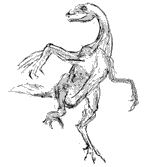
(C) Jess Wallace Protarchaepteryx
1/
The first step is showing predatory dinosaurs with
longer arms and the first signs of feathers. |
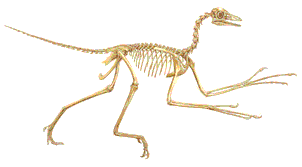
(C) John Sibbick Archaeopteryx
Skeleton
2/
This leads on to
the Archaeopteryx,
part bird,
and part small dinosaur. |
3/
Then moving on to a discussion of the unique part of China which
so carefully preserved fossils in volcanic ash during periodic volcanic
eruptions between 122 and 124 million years ago.
4/ Before looking at a species
of beaked birds, called Confucionis, which lived around 122 million
years ago in Liaoning, and have been found fossilised in large numbers.
These demonstrate the different evolutionary routes that birds have
taken. Namely, that this is a true bird and not a stage on the road
to becoming one, indicating the different development time scales
that are at work.
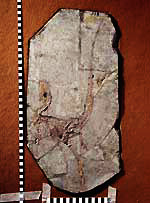
(C) The Geological Museum of China
Synosauropteryx
(juvenile)
5/
Two fossil remains that show a fuzzy covering that is a primitive
feather structure. With Dr Milner speculating that feathers
evolved not as a means to flight, but rather as a means to
warmth, that then subsequently developed to allow flight,
perhaps as a means of escaping predators. |
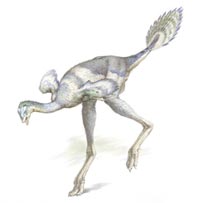
(C) John SibbickCaudipteryx
6/
Then looking
at two examples
of a species
called Caudipteryx
which again
shows a feather structure. |
|
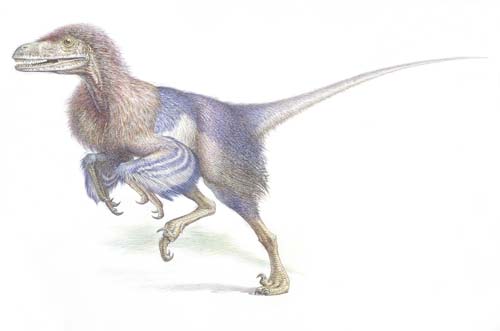
(C) John Sibbick
Artists impression of
the Feathered Dromaeosaur ('Fuzzy Raptor')
7/
Before finally finishing at the 'Fuzzy Raptor', which provided the
crucial evidence to prove the link between dinosaurs and birds. |
| |
Unfortunately however, there are no
guided tours and no tape guides planned for the general public.
The Royal Institute can manage it with their Buddha Exhibition,
why not the Natural History Museum? This is a shame for an exhibition
that is genuinely groundbreaking. Apparently there will be a detailed
leaflet to accompany it, but this wasn’t available at the
press viewing. It took scientists 140 years to properly understand
the link between dinosaurs and birds, and yet the public are expected
to cope with very little explanation of what were the key developments.
That is truly a shame. A tie in book is in the pipeline by Dr Milner,
but again this is not available until November.

(C) The Natural History MuseumLorraine Cornish
works with Feathered Dromaeosaur ('Fuzzy Raptor')
|
A case in point is the ‘Fuzzy
Raptor’ that completes the 140-year story. It was only found
recently in 2001 in Liaoning, China, and is on display here for
the first time. This perfectly preserved fossil shows a dinosaur
skeleton complete with soft, downy body feathers that surround it.
This was the final crucial evidence that was needed to confirm the
relationship between dinosaurs and the birds in your garden. And
yet it was understated in the exhibition, and I only grasped its
importance in the scheme of things after Dr Milner’s talk.
It was seemingly put in the wrong place out of sequence, and when
I initially wandered the exhibition on my own I didn’t grasp
its significance. Yet here is the amazing fossil record that proves
that birds are in fact living dinosaurs!
Confusingly, this is not a linear evolution.
Archaeopteryx is about 147 million years old, while Fuzzy Raptor
is 122 millions years. Archaeopteryx was found in Germany, while
Fuzzy Raptor was found in China. And while it is speculated that
both have a common evolutionary ancestor, the exhibition does not
do an adequate job of explaining how all the different pieces tie
together. Good exhibition, but it leaves nagging doubts.
Summary
FOR: Groundbreaking exhibition
exploring an interesting subject - Unique opportunity to see fossils
that may not be displayed together again - Archaeopteryx on display
for the first time since 1988 (and even then it was displayed for
only 5 months) - Fuzzy Raptor and other fossils have been conserved
wonderfully by the PCU - Fascinating insight into the evolution
of birds - Very intimate exhibition and you can really get close
to the exhibits - Some nice use of video imagery to show birdflight
- Good value if you also consider that the rest of the museum is
free.
AGAINST: More background information
needed - Why no tape guide or guided tours? - The exhibition seemed
to have a logic to it after I was talked around
it, but not before - Lacked a clear timeline throughout the exhibition
both in evolutionary and historical terms - Information was fossil
specific and didn't seem tied to an overall story of developments
- Not always a logical flow to the exhibition, and no real feel
of structure or climax as you reach the end - Virtually no information
given about the Fuzzy Raptor - No foreign language information provided.
Conclusion
This is undoubtedly an exhibition worth
visiting. The subject matter is fascinating and the fossils are
magnificent. But be prepared to be bemused. Explanations are thin
on the ground, the layout of the exhibition is confusing without
guidance, and there is no clear historical or evolutionary timescale's
to assist in placing the material in context.
All this sounds unduly critical in
a way, because I did enjoy the exhibition. However I did feel it
fell short on educating about a subject where such a fine collection
of fossils was at hand to illustrate the developments.
Other Interesting Links
Holding
Hands with Dinosaurs - They pull huge film and television audiences,
but just why are we so fascinated by dinosaurs? This article investigates.
Finding Fossils
from Space - Fossil hunting takes a step into the future with
the use of satellite data to locate new fossil beds in the depths
of the Gobi desert.
Dinosaurs
and Birds - The debate continues...
Dinosaurs
and Birds - Article at the ABC web site.
More
pictures of the fossil finds from China on the National Geographic
Web site.
The
Dino Bird Link...
Argument
from a 'non-believer' as of 1998
|
For more details about the exhibition featured in this review you can
also visit the Official
DinoBirds web page setup by the Natural History Museum.
|
